Chapter 4: Risk adjusted WACC and adjusted present value
Chapter learning Objectives
Upon completion of this chapter you will be able to:
- calculate a suitable project equity beta by degearing and re-gearing betas as appropriate, and use to calculate an appropriate WACC for investment appraisal
- explain the weaknesses of the traditional forms of discounting used in project appraisal where the investment decision will entail significant alterations in the financial structure of the firm and identify when they may not be appropriate
- apply the adjusted present value technique to the appraisal of investment decisions that entail significant alterations in the financial structure of the firm, including the calculation of transaction costs and the tax shield
1 Introduction
Alternatives to the use of existing WACC as a discount rate in project appraisal
We have now established that the existing WACC should only be usedas a discount rate for a new investment project if the business risk andthe capital structure (financial risk) are likely to stay constant.Alternatively,
If the business risk of the new project differs from the entity's existing business risk
A risk adjusted WACC can be calculated, by recalculating the costof equity to reflect the business risk of the new project. This ofteninvolves the technique of 'degearing' and 'regearing' beta factors,covered later in this Chapter.
If the capital structure (financial risk) is expected to change when the new project is undertaken
The simplest way of incorporating a change in capital structure isto recalculate the WACC using the new capital structure weightings. Thisis appropriate when the change in capital structure is not significant,or if the new investment project can be effectively treated as a newbusiness, with its own long term gearing level.
Alternatively, if the capital structure is expected to changesignificantly, the Adjusted Present Value method of project appraisalcould be used. This approach separates the investment element of thedecision from the financing element and appraises them independently.APV is generally recommended when there are complex funding arrangements(e.g. subsidised loans).
2 The risk adjusted WACC
Basic principle
If the business risk of the new project is different from thebusiness risk of a company's existing operations, the company'sshareholders will expect a different return to compensate them for thisnew level of risk.
Hence, the appropriate WACC which should be used to discount thenew project's cashflows is not the company's existing WACC, but a "riskadjusted" WACC which incorporates this new required return to theshareholders (cost of equity).
Calculating a risk-adjusted WACC
(1) Find the appropriate equity beta from a suitable quoted company.
(2) Adjust the available equity beta to convert it to an asset beta – degear it.
(3) Readjust the asset beta to reflect the project (i.e. its own) gearing levels – regear the beta.
(4) Use beta to find Ke.
(5) Use this Ke to find the WACC.
(6) Evaluate the project.

 Test your understanding 1
Test your understanding 1
B plc is a hot air balloon manufacturer whose equity:debt ratio is5:2. The corporate debt, which is assumed to be risk free, has a grossredemption yield of 11%. The beta value of the company’s equity is1.1. The average return on the stock market is 16%. The corporation taxrate is 30%.
The company is considering a waterbed-manufacturing project. S plcis a waterbed-manufacturing company. It has an equity beta of 1.59 and aVe:Vd ratio of 2:1. B plc will finance the project to maintain its existing capital structure.
What would be a suitable cost of capital to apply to the project?

Student Accountant articles
Read Ken Garrett's articles in the October and November 2009 issuesof Student Accountant magazine for more details on the risk adjustedWACC.
Using the risk-adjusted WACC
The risk-adjusted WACC calculated above reflects the business riskof the project and the current capital structure of the business, so itis wholly appropriate as a discount rate for the new project.
Two other issues also need to be considered:
- The method used to gear and degear betas is based on the assumption that debt is perpetual. This overvalues the tax shield where debt is finite.
- Issue costs on equity are ignored.

 Theoretical points re: risk adjusted WACC
Theoretical points re: risk adjusted WACC
The degearing and regearing procedure is a product of the M&M1963 position. To use these equations debt must be perpetual andrisk-free. If it is not perpetual, to ignore that it is for a shorterperiod will overvalue the tax shield on debt.
The value Ve + Vd used in the WACC equationshould represent market values of debt and equity after the project hasbeen adopted (i.e. the equity value should include the NPV of theproject).
By using the ratio of the company before the project we haveassumed that the project has a zero NPV – this is unlikely to be thecase. If the project has a positive NPV the calculation will assume thatborrowing is proportional to the present value of future cash flowsrather than the initial value of the asset.

3 The adjusted present value (APV) technique
Basic principle
The APV method evaluates the project and the impact of financingseparately. Hence, it can be used if a new project has a differentfinancial risk (debt-equity ratio) from the company, i.e. the overallcapital structure of the company changes.
APV consists of two different elements:

The investment element (Base case NPV)
The project is evaluated as though it were being undertaken by anall equity company with all financing side effects ignored. Thefinancial risk is quantified later in the second part of the APVanalysis. Therefore:
- ignore the financial risk in the investment decision process
- use a beta that reflects just the business risk, i.e.ß asset.
Once the base case NPV is identified, the PV of the financing package is evaluated.
The financing impact
Financing cash flows consist of:
As all financing cash flows are low risk they are discounted at either:
- the Kd or
- the risk free rate.

 Examples of exam tricks on APV
Examples of exam tricks on APV
APV tricks
In exam questions, you may see the following tricks whencalculating the "financing impact" part. All these tricks are covered inthe next "Test your understanding" questions:
Grossing up
A firm will know how much finance is required for the investment.Issue costs of finance will usually be quoted on top. It will thereforebe necessary to gross up the funds to be raised.
Grossing up illustration
The finance required for a planned investment is $2m (net of issuecosts). Issue costs are 3%. And the finance raised will also have tocover the issue costs.
What are the issue costs and what sum will need to be raised altogether?
Solution
The $2m is 97% of the amount to be raised:
Therefore, ($2m/0.97) = $2,061,856 will be needed.
Issue costs are 3%
3% × $2,061,856 = $61,856
Issue costs can be calculated in one stage as:
$2m × 3/97 = $61,856
PV of debt issue costs
As always, calculations involving debt must take account of the tax effects.
Method:

PV of the tax relief on interest payments
The PV of the tax relief on interest payments is also known as the PV of the tax shield.
The method adopted depends on the information given:
Simple scenario: Debentures – interest paid at a fixed amount each year
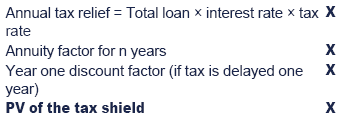
More complex scenario: Bank loans – repayments are for equal amounts
The repayments will be made up of both interest and capital elements.
Step 1
Find the amount of the repayment
Annual amount = (Amount of the loan/Relevant annuity factor)
Step 2
Compute the annual interest charge.
Illustration of the more complex scenario
$400,000 is to be borrowed for 3 years and repaid in equalinstalments. The risk-free rate is 10% and all debt is assumed to berisk free. Calculate the present value of the tax relief on the debtinterest if the corporation tax rate is 30%. Assume that tax is delayed 1year.
Solution
Equal annual repayment = 400,000 / 3yr AF@10% = 400,000/2.487 = $160,836

The tax relief on the interest can now be calculated:

Calculation of APV (in detail)
The base case NPV is used as a starting point. The costs andbenefits of the financing are then added to find a final adjustedpresent value:
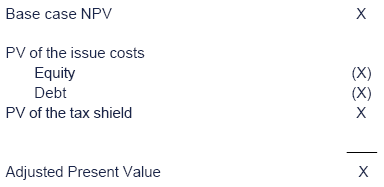
A fully worked example now follows.


 Test your understanding 2
Test your understanding 2
Rounding plc is a company currently engaged in the manufacture ofbaby equipment. It wishes to diversify into the manufacture ofsnowboards.
The investment details
The company’s equity beta is 1.27 and is current debt to equityratio is 25:75, however the company’s gearing ratio will change as aresult of the new project.
Firms involved in snowboard manufacture have an average equity beta of 1.19 and an average debt to equity ratio of 30:70.
Assume that the debt is risk free, that the risk free rate is 10% and that the expected return from the market portfolio is 16%.
The new project will involve the purchase of new machinery for acost of $800,000 (net of issue costs), which will produce annual cashinflows of $450,000 for 3 years. At the end of this time it will have noscrap value.
Corporation tax is payable in the same year at a rate of 33%. Themachine will attract writing down allowances of 25% pa on a reducingbalance basis, with a balancing allowance at the end of the project lifewhen the machine is scrapped.
The financing details:
The new investment will be financed as follows:

The issue costs are 4% on the gross equity issued and 2% on the gross debt issued.
Estimate the adjusted present value of the project.


 Test your understanding 3
Test your understanding 3
Blades plc is considering diversifying its operations away from itsmain area of business (food manufacturing) into the plastics business.It wishes to evaluate an investment project, which involves the purchaseof a moulding machine that costs $450,000. The project is expected toproduce net annual operating cash flows of $220,000 for each of thethree years of its life. At the end of this time its scrap value will bezero.
The assets of the project will support debt finance of 40% of its initial cost (including issue costs).
The loan is to be repaid in three equal annual instalments. Thebalance of finance will be provided by a placing of new equity. Issuecosts will be 5% of funds raised for the equity placing and 2% for theloan. Debt issue costs are allowable for corporation tax.
The plastics industry has an average equity beta of 1.368 and anaverage debt:equity ratio of 1:5 at market values. Blade’s currentequity beta is 1.8 and 20% of its long-term capital is represented bydebt which is generally regarded to be risk-free.
The risk-free rate is 10% pa and the expected return on an average market portfolio is 15%.
Corporation tax is at a rate of 30%, payable in the same year. Themachine will attract a 70% initial capital allowance and the balance isto be written off evenly over the remainder of the asset life and isallowable against tax. The firm is certain that it will earn sufficientprofits against which to offset these allowances.
Calculate the adjusted present value and determine whether the project is worthwhile.


 Additional factors regarding the APV method
Additional factors regarding the APV method
Additional factors – subsidised/cheap loans
If a loan is cheap, the interest cost is lower. However, the benefit is reduced since the tax shield will also be lower:
PV of the cheap loan (opportunity benefit):

Example: A plc requires $1 million in debt finance for 5 years.
It has borrowed $700,000 in the form of 10% debentures redeemablein 5 years and the remainder under a government subsidised loan schemeat 6%. The tax rate is 30%. Assume that tax is delayed one year.
Calculate the PV of the tax shields and the PV of the cheap loan.
(a) PV of the tax shields
Although the cheap loan has a cost of 6% it has the same risk as anormal loan, therefore the appropriate discount rate is 10% pa.

(b) PV of the cheap loan


The APV calculation is therefore amended as follows:
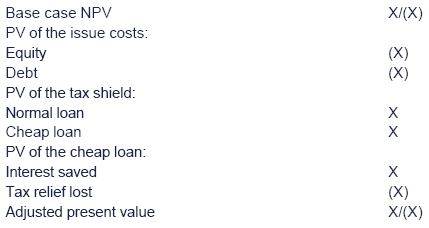
Additional factors – debt capacity
Debt finance benefits a project because of the associated taxshield. If a project brings about an increase in the borrowing capacityof the firm, it will increase the potential tax shield available.
An occasional exam trick is to give both the amount of debtactually raised and the increase in debt capacity brought about by theproject. It is this theoretical debt capacity on which the tax shieldshould be based.
A project’s debt capacity denotes its ability to act as securityfor a loan. It is the tax relief available on such a loan, which givesdebt capacity its value.
When calculating the present value of the tax shield (tax relief oninterest) it should be based on the project’s theoretical debtcapacity and not on the actual amount of the debt used.
The tax benefit from a project accrues from each pound of debtfinance that it can support, even if the debt is used on some otherproject. We therefore use the theoretical debt capacity to match the taxbenefit to the specific project.
For example, if a question stated that actual debt raised is$800,000 but you are told in the question ‘The investment is believedto add $1 million to the company’s debt capacity.’ The present valueof the tax shield is based on the £1 million – the theoreticalamount.

Advantages and disadvantages of APV
The APV technique has practical advantages and theoretical disadvantages.

4 Chapter summary
Test your understanding answers

 Test your understanding 1
Test your understanding 1
Step 1
B Plc has selected an appropriate equity beta for waterbed-manufacturing of 1.59
Step 2
Based on new industry information:
- the ß equity (1.59)
- gearing ratio of the new industry (2:1)
de-gear the equity beta of the company in the new industry and find the business risk asset beta of the new project/industry.
= 1.59 × (2/(2 + 1(1 - 0.3)))
= 1.18
Step 3
Calculate the equity beta of the new project, by re-gearing:
Now proceed as usual
Calculate the cost of equity of the project based on CAPM:
Ke = RF + ß (E(RM) - RF) = 11% + 1.51 (16% - 11%) = 18.55%
Find the cost of debt:
Kd = I (1 – T)
Kd = 11% (1 – 0.3) = 7.70%
Calculate the WACC of the project.
(Use our company’s D:E ratio)
WACC = 18.55% × 5/7 + 7.70 × 2/7 = 15.45%
We have calculated a discount rate, which reflects the systematic risk of this particular project.


 Test your understanding 2
Test your understanding 2
The investment element
Estimate the base case NPV.
Firstly compute the asset beta of the project. This is achieved bydegearing the equity beta from the snowboard industry average.
ßa = ße × [Ve/(Ve + Vd(1 - T))]
ßa = 1.19 × (70/(70 + 30(1 - 0.33)))
ßa = 0.92
The next task is to determine the base case discount rate for the project.
E(Ri)= Rf + (E(Rm) - Rf) ßa
= 10% + (16% - 10%) 0.92
= 15.52% – round to the nearest % point so we can use the tables.
Therefore we will use 16%.
(1) Base case NPV calculation

Capital allowances computation W1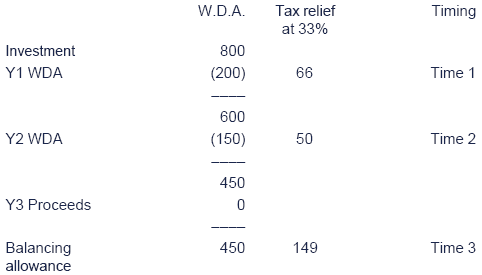
(2) The financing impact
Lay out the financing package:

A PV of issue costs on equity
The question states that the $800k is net of issue costs therefore we need to gross up.
Equity issue cost: $480,000 × 4/96 = ($20,000)
B PV of issue costs on debt
Debt issue cost: $320,000 × (2 /98) ($6,531)

C PV of the tax shield
Total amount raised by loan – don’t forget to add the issue costs
= $320,000 + $6,531 = $326,531

(3) The APV calculation
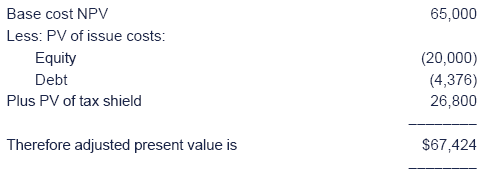
Based upon these estimates the project appears financially viable.


 Test your understanding 3
Test your understanding 3
Step 1: Base case net present value
First compute the ungeared (asset) beta for this project type (based on the equity beta for the plastics industry).

Then discount the project cash flows at 16%
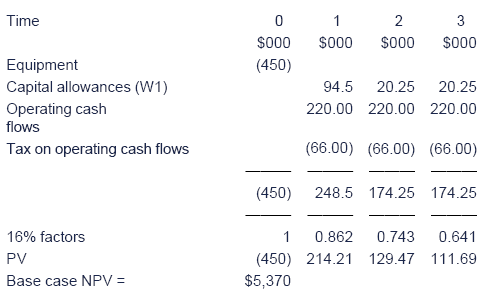
Workings
W1 – Capital allowances

Step 2: Adjusted present value (the financing side effects)
Lay out the financing package:
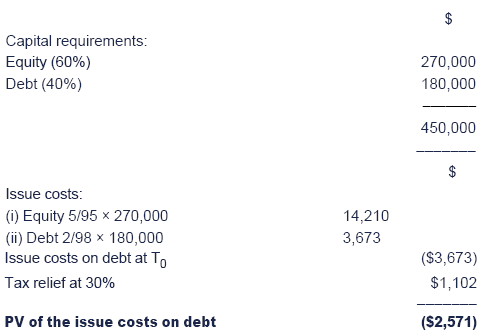
(iii) Tax relief on loan interest
Gross value of loan = $180,000 + $3,673 (issue costs) = $183,673
Annual repayments = $183,673/2.487 = $73,853
Loan schedule

Tax relief at 30% on interest:

Step 3: Adjusted present value
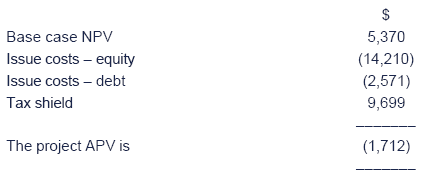
The project will reduce shareholder wealth by $1,712 and is not acceptable.

|
Created at 5/24/2012 3:51 PM by System Account
(GMT) Greenwich Mean Time : Dublin, Edinburgh, Lisbon, London
|
Last modified at 5/25/2012 12:55 PM by System Account
(GMT) Greenwich Mean Time : Dublin, Edinburgh, Lisbon, London
|
|
|
|
 |
Rating
:
|
 Ratings & Comments
(Click the stars to rate the page) Ratings & Comments
(Click the stars to rate the page)
|
 |
Tags:
|
|
|
|
|